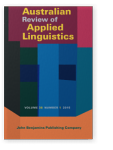Vol. 38:1 (2015) ► pp.50–65
Contemporary tutorial call
Using purpose-built video as a grammar tutor
Despite an increased emphasis on form-focused instruction (FFI), the use of the computer as a grammar tutor has remained largelyunexamined for nearly two decades. With new technologies at hand, there is a need to take a fresh look at online grammar tutors andlink designs more strongly to contemporary second language acquisition (SLA) principles and the concept of a teaching presence. Theaim of this study, therefore, is to investigate the potential of using a purpose-built digital video series as a virtual grammartutor. To achieve this aim, we used a pre-test, post-test, and delayed post-test to evaluate the impact of a purpose-built grammar video on 62 EFL university students. The results of the study demonstrate that purpose-built video has strong potential for use as a virtual grammar tutor. Consequently, it may be possible to improve the state of Tutorial CALL from a drill-based approach to one that is more substantive through the development of a series of step-based video tutorials that tutor, allow for the practice of and evaluate second language (L2) grammar skills.
For any use beyond this license, please contact the publisher at [email protected].
